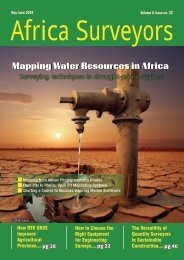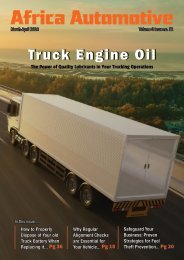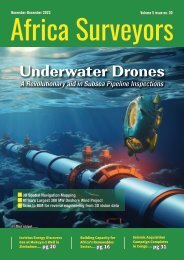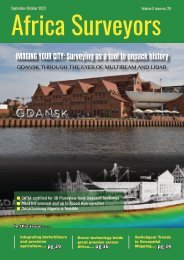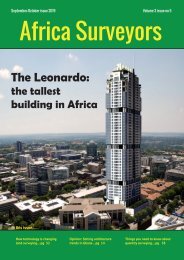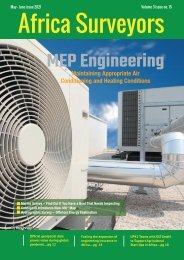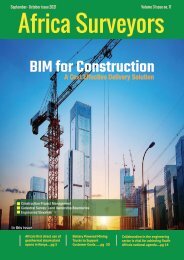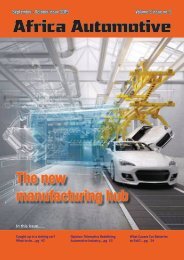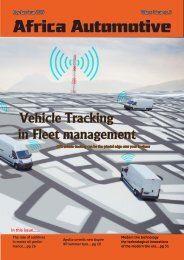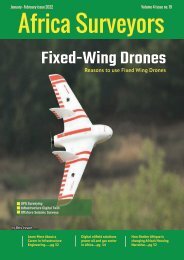Africa Surveyors May-June issue 2023 digital
Africa Surveyors is Africa’s premier source of Surveying, Mapping and Geospatial news and an envoy of surveying products/service for the Construction, Maritime, Onshore & Offshore energy and exploration, Engineering, Oil and Gas, Agricultural and Mining sectors on new solution based trends and technology for the African market.
Africa Surveyors is Africa’s premier source of Surveying, Mapping and Geospatial news and an envoy of surveying products/service for the Construction, Maritime, Onshore & Offshore energy and exploration, Engineering, Oil and Gas, Agricultural and Mining sectors on new solution based trends and technology for the African market.
Create successful ePaper yourself
Turn your PDF publications into a flip-book with our unique Google optimized e-Paper software.
LASER TECHNOLOGY<br />
Laser technology, the<br />
real revolution of the<br />
Aeolus mission<br />
Aeolus, a European Space Agency (ESA) satellite launched<br />
into Space in 2018, is now preparing to return to Earth after<br />
successfully acquiring profiles of the Earth’s wind across the<br />
Planet from an altitude of 30 km.<br />
The Aeolus satellite features ALADIN (Atmospheric LAser Doppler<br />
INstrument), a LIDAR (Light Detection and Ranging) comprising three<br />
parts: a telescope, a receiver, and a laser transmitter, made in Italy by<br />
Leonardo with the support of the Italian Space Agency (ASI).<br />
It is the most powerful transmitter in the ultraviolet (UV) range ever<br />
built for space missions. With over seven billion laser pulses emitted,<br />
it orbited the Earth 16 times a day, covering the entire globe once a<br />
week. It comprises over 80 optical elements aligned with micrometric<br />
accuracy, and its manufacture involves innovative technologies<br />
and materials never tested before. Prime examples are the laser’s<br />
internal oxygenation system, developed to ensure that the beam is<br />
not deformed and does not burn the internal components, and the<br />
material used to minimise light absorption, and at the same time,<br />
withstand the high power levels, thus avoiding energy dispersion or<br />
damage to the optics.<br />
Laser technology is Aeolus’ real revolution. By generating pulses of<br />
UV light sent into the atmosphere, LIDAR detects winds worldwide.<br />
This mission’s greatest added value was the measurement of winds in<br />
areas inaccessible to classic surveying equipment (weather balloons or<br />
aircraft), thereby offering a fuller and more comprehensive view of this<br />
phenomenon.<br />
In orbit for nearly five years, the mission positively impacted many<br />
areas: it has helped to enhance the accuracy of weather forecasts and<br />
improved knowledge of climate phenomena and of the consequences<br />
of global warming and air pollution. According to the mission data,<br />
scientists have hypothesised that, in the future, it could help improve<br />
hurricane forecasting, and track and predict the movement of dust<br />
emissions, e.g., from volcanic eruptions.<br />
Between the end of operations (on 30 April) and the shutdown<br />
of ALADIN (on 5 July), Leonardo, together with ESA and the space<br />
industries involved, carried out further tests on the laser transmitter’s<br />
emission capabilities, upgrading it from a power output of around 4<br />
million nominal watts, to around 10 million watts. A record for a space<br />
laser.<br />
www.africasurveyorsonline.com<br />
<strong>May</strong>-<strong>June</strong> <strong>issue</strong> l <strong>2023</strong> 33




